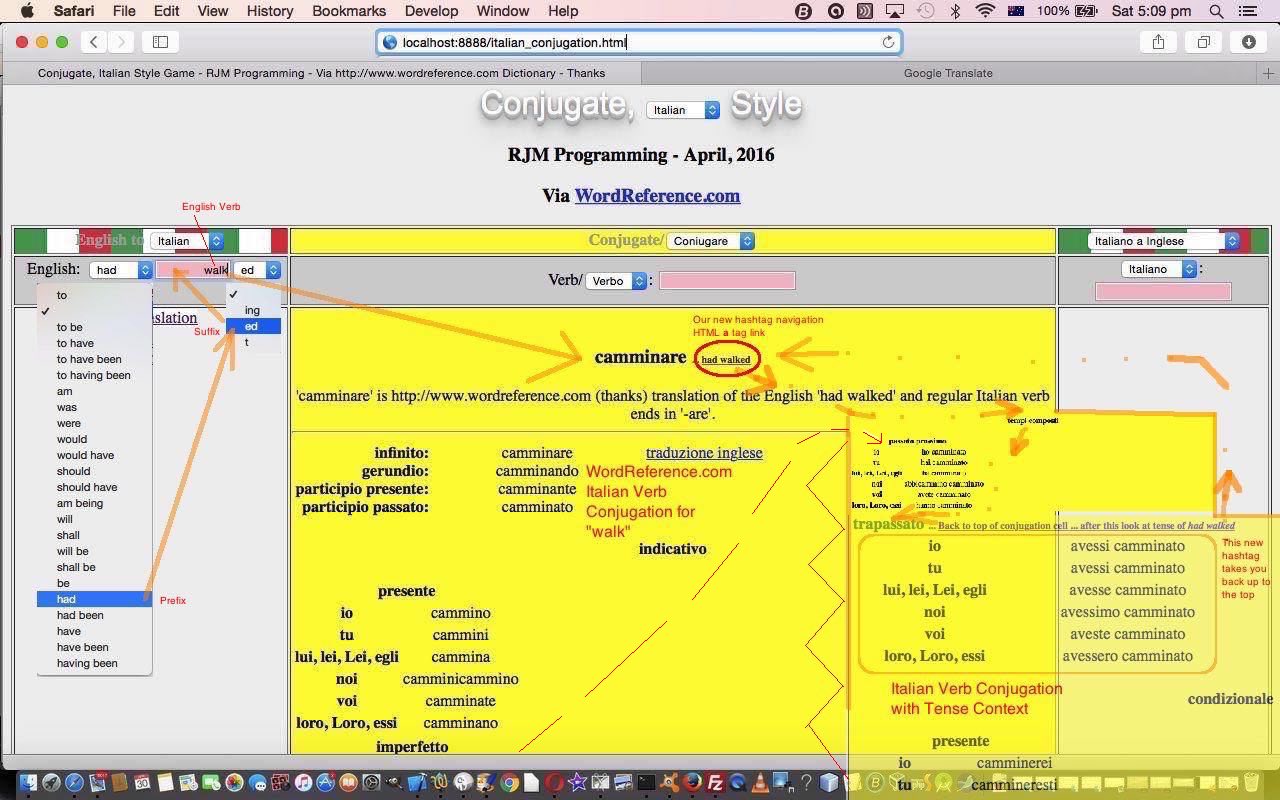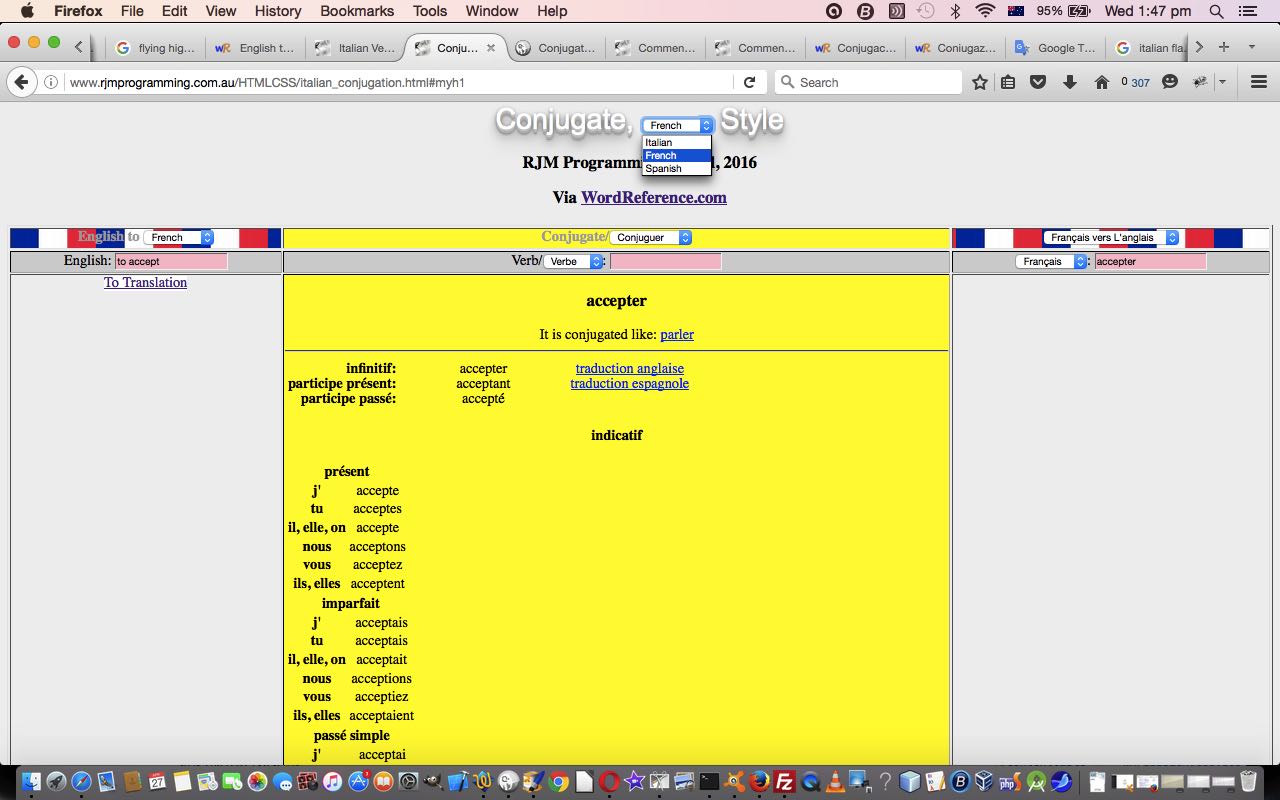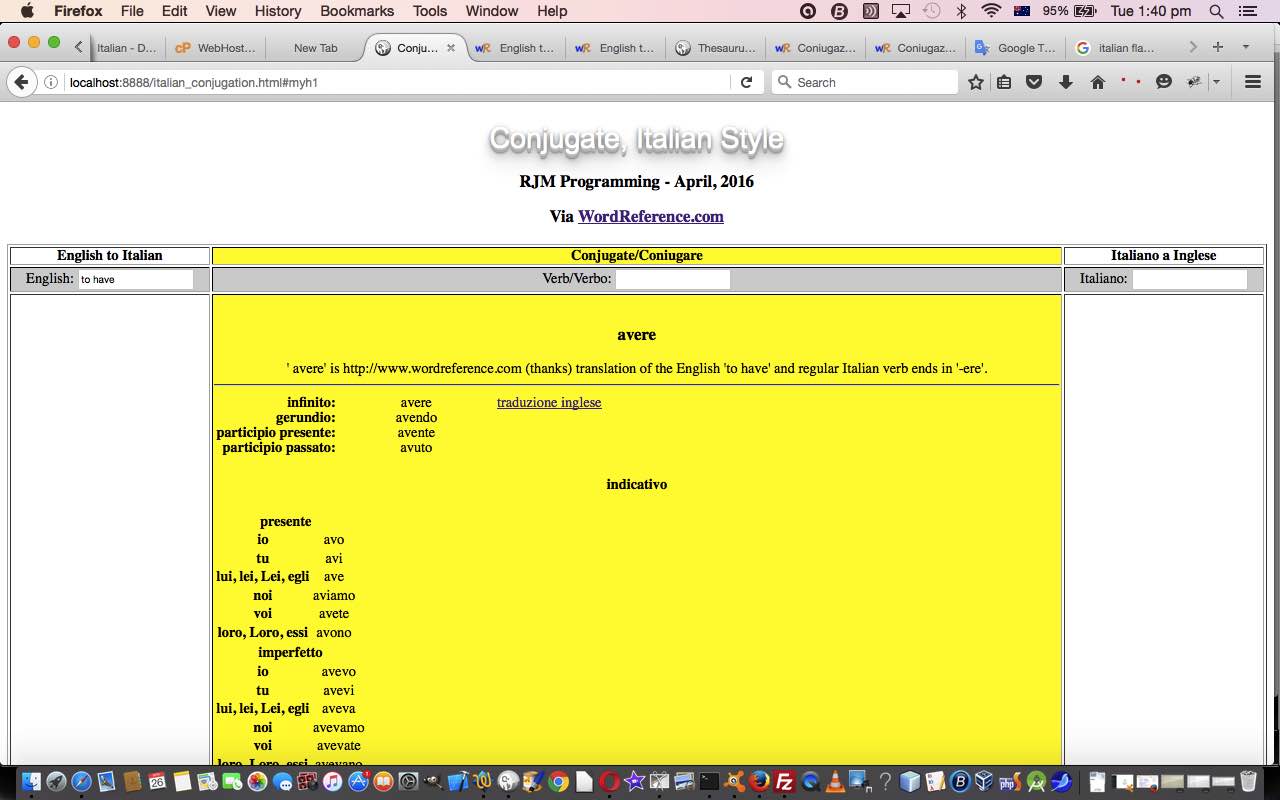Again, we saw that we could extend the functionality of the recent Italian and French and Spanish Verb Conjugation Tutorial as shown below, by, for Italian, to start with, trying to help the native English speaker out for where to look on the “conjugation” table presented for the English verb of interest, regarding conjugation information that might match their (verb) tense of interest.
As you probably well know, every language on Earth has its peculiarities regarding how we express ourselves with regard to time, and a lot of that is associated with the verbs, or action words we use, and in the case of …
- Italian
- French
- Spanish
… that expression of the context of time in the grammatical usage, especially for people speaking the language, is reflected by conjugations made to the verb. Conversely, as I, a native English speaker, got to think about as this web application proceeded, English has words like “am” and “have” and “having” and “been” and “will” and “shall” and “is” and “are” and “was” and “were” and “would” and “should” and “has” and “had” and “to” and ‘”be” and “being” preceeding verbs, which can have, basically, two suffixes “-ing” and “-ed” (expressing present participles and past participles respectively) to try to do what conjugation does for Italian (we program for today) and French and Spanish languages.
But there’s more to “tense” than Past, Present and Future as you well can imagine should you learn a language other than your native tongue, which you tend to “go along with the flow” perhaps unaware that “tense” exists, for some learners. There are concepts as layers on top about the context of the time the person is speaking relative to the time they are or were talking about … it gets complex … so you get concepts like “Present Perfect Progressive” (which we did a tutorial about at HTML/Javascript Present Perfect Progressive Primer Tutorial) if you get right into the ins and outs of all this grammar … which you might need to do to master that second language.
Yet again, nothing changes about the techniques used today doing away with any need for a server side language by channelling the Ajax jQuery thoughts we presented with Ajax jQuery Primer Tutorial to make the most of the great resource that WordReference.com is. This happens in our HTML and Javascript programming source code you could call italian_conjugation.html, which changed to add in Italian “tense” thoughts in this way, with this live run link.
Again, we hope you try some Italian, with specified “tense” prefix words and suffix endings, to see how the new functionality helps you out with Italian verb conjugations.
Previous relevant Italian and French and Spanish Verb Conjugation Tutorial is shown below.
We saw that we could extend the functionality of yesterday’s Italian Verb Conjugation Primer Tutorial as shown below, by accessing other resources from the great WordReference.com, adding French and Spanish verb conjugation to yesterday’s Italian verb conjugation.
As a rule we tend to find that replacing text with HTML select “dropdown” menus can help out this adaption pretty effectively. The other feature of today’s Javascript coding is the use of eval to team with the language code to direct user traffic to the correct parts of the WordReference.com website.
Along the way we added some background “flag” imagery we found at Science Kids … thanks, heaps.
Down the little brick road we also added a couple of hashtag navigators, HTML a links that just navigate within the page, allowing the user to move from the conjugation yellow zone to the translation zone (if you translated from English), as much as anything because the conjugation may need to be prompted by picking the “verb” amongst the list of “translated” possibilities, which you can then feed into the rightmost HTML input type=text textbox to, more than likely, get the (verb) conjugation you may have missed with the first pass.
Nothing changes about the techniques used today doing away with any need for a server side language by channelling the Ajax jQuery thoughts we presented with Ajax jQuery Primer Tutorial to make the most of the great resource that WordReference.com is. This happens in our HTML and Javascript programming source code you could call italian_conjugation.html, which changed to add in French and Spanish in this way, with this live run link.
Hope you try it out.
Previous relevant Italian Verb Conjugation Primer Tutorial is shown below.
Learning Italian as a native English speaker is best done when you are young, and beginning recently on this quest, I learnt a bit of this.
To me, what stuck out, was how easy we get it in English with regard to (the lack of) conjugating verbs, or articles, or adjectives, in our grammar.
Is it that, in English, we can say something in a hurry and, sort of, wait to fix it up later, because we don’t conjugate verbs in our mind, or is this not how it works in other languages? Actually, am pretty sure no, because conjugation is done so fast in the minds of Italian speakers that it is no issue … hard to imagine, though, from where I’m standing … well, actually, sitting. Am not here to say, but know it is this, that teachers of Italian to English native speakers, concentrate on in early lessons.
With this in mind, we don’t for one second pretend we are not using the wonderful resources at WordReference.com with today’s web application, but we thank them for their brilliance, and just rearrange things that you could glean perfectly well from here but need to take a few more steps to reach the conjugation (today it’s just verbs) web page bits, whereas we throw the conjugation bits straight at you. And yes, we do try to cater for the irregular verbs, and where they are regular you should see the word “regular” mentioned in the yellow zone conjugation areas … because we all know … well, you know what we mean?!
The techniques used today do away with any need for a server side language by channelling the Ajax jQuery thoughts we presented with Ajax jQuery Primer Tutorial to make the most of the great resource that WordReference.com is. This happens in our HTML and Javascript programming source code you could call italian_conjugation.html with this live run link.
So we hope you enjoy this break from our usual (other way around) ESL game (if it’s a game) to some “Conjugate, Italian Style” play.
If this was interesting you may be interested in this too.
If this was interesting you may be interested in this too.
If this was interesting you may be interested in this too.






6 Responses to Italian Verb Conjugation and Tense Tutorial